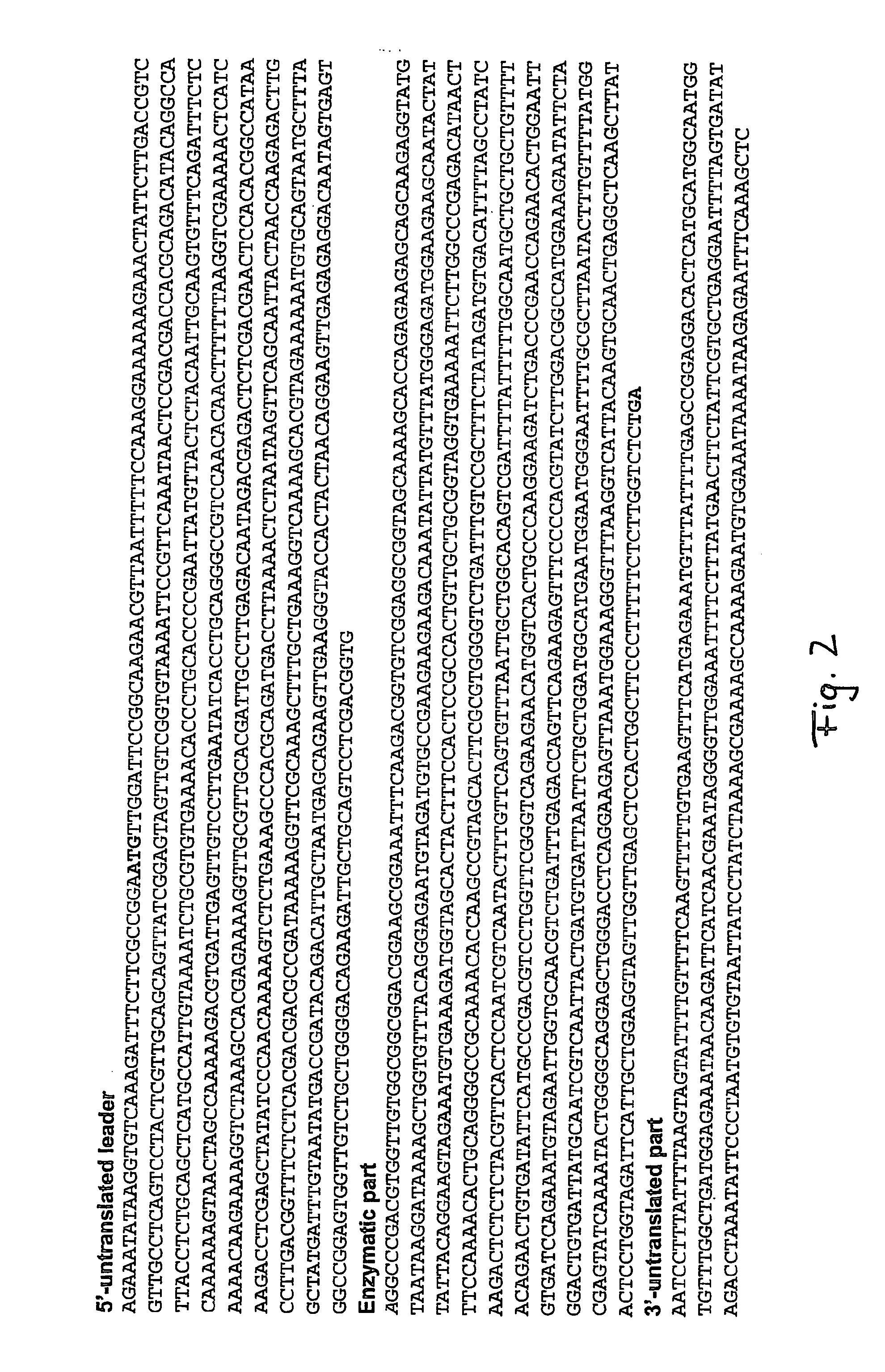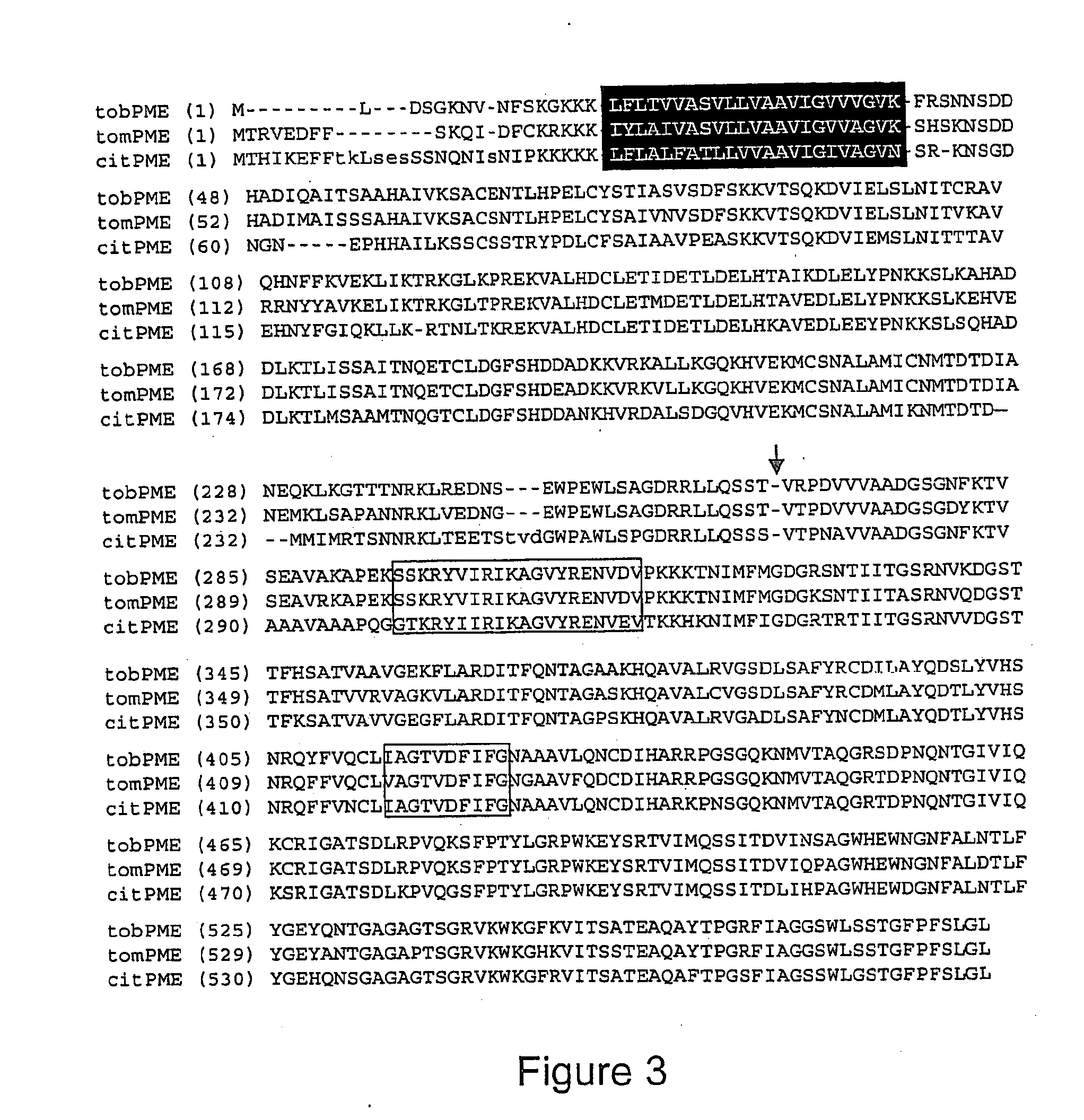Method of protein production in plants
a plant protein and protein technology, applied in the field of plant protein production, can solve the problems of less consideration of the technical challenges associated with downstream protein purification from plant material, the cost and complexity of protein recovery and purification, and more than 90% of the total production cost, so as to reduce the cost of plants, the molecular farmer is more flexible, and the effect of increasing production
- Summary
- Abstract
- Description
- Claims
- Application Information
AI Technical Summary
Benefits of technology
Problems solved by technology
Method used
Image
Examples
example 1
[0164] Construction of Vectors Carrying Different Types of GFP Fusions with the Tobacco Pectin Methylesterase (PME) Gene for Transient Expression and Stable Nuclear Transformation of Plants
[0165] A red-shifted mutant of GFP (GFPst65T) was chosen for fusion with PME to determine the location of GFP in vivo. The following four constructs were created: 1) full length PME-GFP; 2) GFP-mature PME; 3) GFP-full length PME and 4) mature PME-GFP. The first construct was designed for targeting the protein of interest (GFP) to the cell wall. Constructs 24 were used as negative controls.
[0166] Plasmid pUC8 containing a full sequence of an unprocessed PME gene with untranslated 5' and 3'-regions was used for PCR amplification with the following primers:
[0167] a) 5'-TGACCCATGGTGGATTCCGGCMGAACGTT-3', corresponding to the N-terminal part of the PME coding sequence and containing a NcoI site.
[0168] b) 5'-TTttGGATCCACGGAGACCAAGAGAAAAAG-3', corresponding the C-terminal part of the PME coding sequence a...
example 2
[0185] Transient Expression of the PME-GFP Fusion in Nicotiana benthamiana Leaves
[0186] Plasmid DNA Preparation
[0187] Plasmids carrying p35S:flPME-GFP, p35S:mPME-GFP, p35S:GFP-flPME, and p35S:GFP-mPME fusions were transformed into E. coli strain DH10B, maxi preps were grown in LB medium and DNA was purified using the Qiagen kit.
[0188] Microproiectile Bombardment
[0189] Microprojectile bombardment was performed utilizing the Biolistic PDS-1000 / He Particle Delivery System (Bio-Rad). The cells were bombarded at 900-1100 psi, at 15 mm distance from a macrocarrier launch point to the stopping screen and 60 mm distance from the stopping screen to a target tissue. The distance between the rupture disk and the launch point of the macrocarrier was 12 mm. The cells were bombarded after 4 hours of osmotic pretreatment.
[0190] A DNA-gold coating according to the original Bio-Rad's protocol (Sanford et al., 1993, In: Methods in Enzymology, ed. R. Wu, 217, 483-509) was done as follows: 25 .mu.l of ...
example 3
[0192] Agrobacterium-Mediated Transformation of Arabidopsis thaliana
[0193] Construct Design
[0194] The large Nhe1-EcOR1 fragments of plasmids p35S:flPME-GFP, p35S:mPME-GFP, p35S: GFP-flPME and p35S:GFP-mPME described in Example 1 werte ligated with the large Xba1-EcOR1 fragment of binary vector plCBV1. Resulting plasmids plCBV flPME-GFP, plCBV1 mPME-GFP, plCBV1 GFP-flPME and plCBV1 GFP-mPME contained the p35S:flPME-GFP, p35S:mPME-GFP, p35S:GFP-flPME and p35S:GFP-mPME expression cassettes in T-DNA region with the BAR gene as selectable marker. The T-DNA region of one construct, plCBV flPME-GFP is shown in FIG. 8.
[0195] In Planta Transformation of Arabidopsis thaliana
[0196] The plasmids (carbenicillin resistant) were immobilized into Agrobacterium tumefaciens (strain GV 2260) by electroporation. The bacterial cells were grown in 300 ml 2YT media with antibiotics, collected by centrifugation and resuspended in 5% sucrose to OD.sub.600=0.8.
[0197] A. thaliana plants were grown until flowe...
PUM
| Property | Measurement | Unit |
|---|---|---|
| distance | aaaaa | aaaaa |
| distance | aaaaa | aaaaa |
| distance | aaaaa | aaaaa |
Abstract
Description
Claims
Application Information
 Login to View More
Login to View More - R&D
- Intellectual Property
- Life Sciences
- Materials
- Tech Scout
- Unparalleled Data Quality
- Higher Quality Content
- 60% Fewer Hallucinations
Browse by: Latest US Patents, China's latest patents, Technical Efficacy Thesaurus, Application Domain, Technology Topic, Popular Technical Reports.
© 2025 PatSnap. All rights reserved.Legal|Privacy policy|Modern Slavery Act Transparency Statement|Sitemap|About US| Contact US: help@patsnap.com



